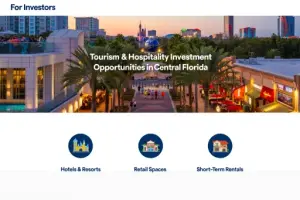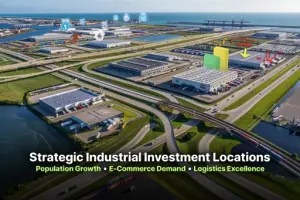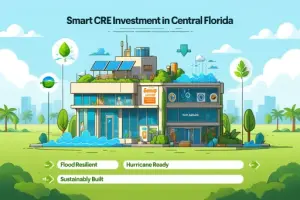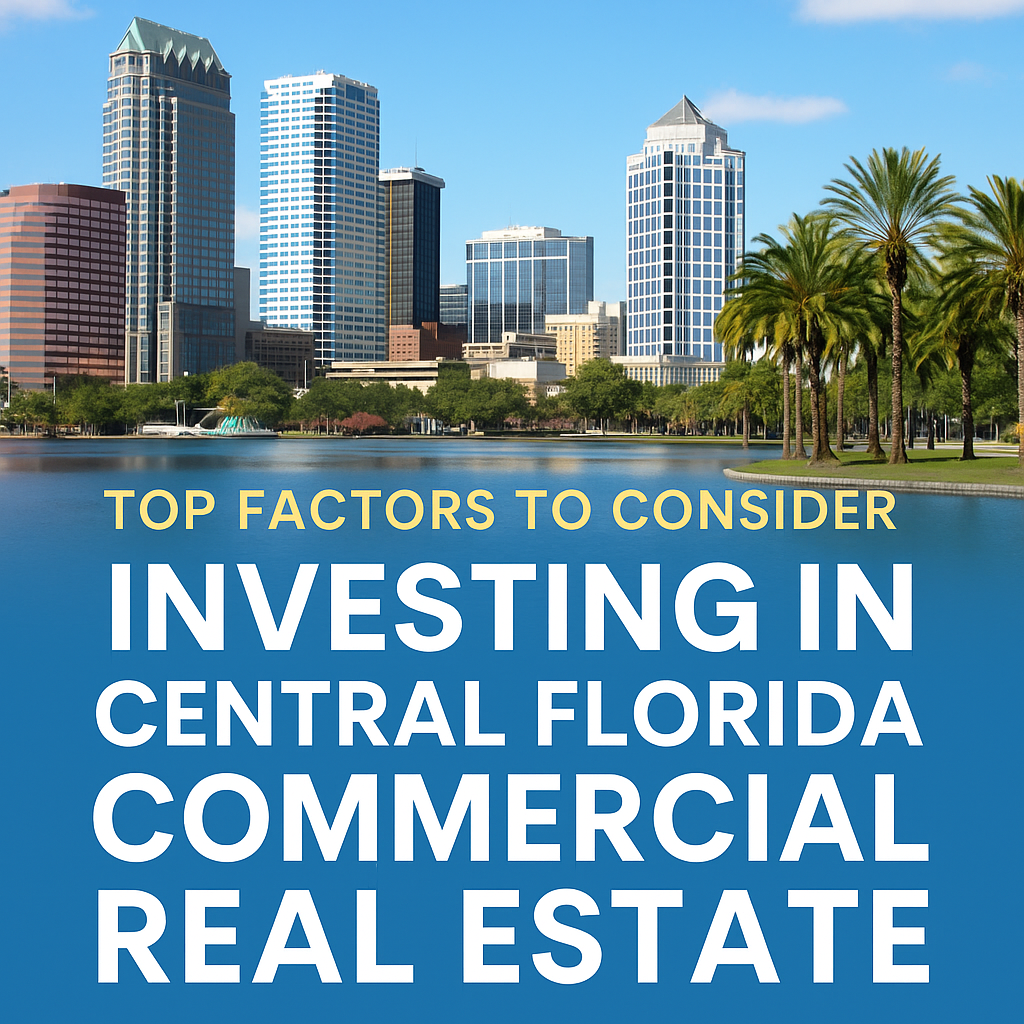Central Florida, home to thriving cities such as Orlando, Tampa, and Lakeland, is one of the fastest-growing regions in the United States. Known for its favorable climate, business-friendly policies, and diverse economy, Central Florida has become a hotspot for commercial real estate (CRE) investors. However, like any investment, success in Central Florida’s CRE market depends on a nuanced understanding of various factors that can significantly impact your investment outcomes.
This article explores the top factors to consider when investing in Central Florida commercial real estate, providing insights that will help you make informed decisions and maximize your returns.
1. Regional Economic Growth and Diversification
One of the key reasons Central Florida has attracted significant investment in recent years is its economic growth and diversified economy. While the region is widely known for its tourism industry, particularly around Orlando’s theme parks, the local economy is increasingly driven by other sectors:
- Technology: Orlando has emerged as a technology hub, with strong growth in areas such as simulation technology, fintech, and aerospace engineering.
- Healthcare: Central Florida’s healthcare and life sciences sectors are booming, driven by increasing demand for medical facilities, hospitals, and research institutions.
- Logistics and Warehousing: Tampa and Lakeland are positioned as key logistics hubs due to their proximity to major highways, ports, and railroads. The rise of e-commerce has made industrial real estate in these areas particularly valuable.
When investing in Central Florida CRE, consider whether the property aligns with these growth sectors, as they offer long-term potential and reduced risk from economic downturns.
2. Population Growth and Demographics
Central Florida is experiencing one of the fastest rates of population growth in the U.S., driven by an influx of retirees, young professionals, and immigrants. With an average of 1,000 new residents moving to Florida every day, this demographic shift supports a growing demand for commercial spaces, including:
- Retail: As new neighborhoods develop and more people move into the region, there is increasing demand for retail spaces such as shopping centers, restaurants, and service-oriented businesses.
- Office Spaces: Orlando and Tampa, in particular, have become magnets for corporate relocations, startups, and professional services firms looking for affordable office spaces in growing urban areas.
- Multifamily and Mixed-Use Developments: High population growth translates into increased demand for rental properties, particularly in urban areas where mixed-use developments (combining residential, retail, and office space) are becoming more common.
Understanding the population trends in the area you’re investing in—whether it’s retirees or younger professionals—can help you determine which type of commercial property will be in high demand.
3. Tourism and Hospitality Industry

Central Florida’s tourism industry is one of its most well-known economic drivers, particularly in the Orlando area. Walt Disney World, Universal Studios, and other theme parks draw millions of visitors every year, contributing to a thriving hospitality and retail sector.
For CRE investors, this opens up opportunities in several types of properties:
- Hotels and Resorts: The hospitality industry remains a strong investment, particularly in areas surrounding major attractions. Investors should look for properties that are well-positioned to capture seasonal tourism demand.
- Retail Spaces: Shops, restaurants, and entertainment venues located near tourist attractions tend to see consistent foot traffic. However, it’s essential to consider the seasonality of tourism, which can fluctuate and affect revenue.
- Short-Term Rental Properties: The growing popularity of short-term rentals (Airbnb, VRBO) in tourist-heavy areas provides another investment avenue for CRE investors, particularly those interested in mixed-use or residential properties that can accommodate vacationers.
Despite its strengths, tourism is inherently tied to economic cycles and global events (such as pandemics), so investors should weigh the risks of seasonality and economic downturns when considering hospitality-related CRE investments.
4. Transportation and Infrastructure Development

Another factor bolstering Central Florida’s CRE market is its robust transportation network and ongoing infrastructure improvements. The region is a logistics hub with easy access to:
- Interstate 4 (I-4), which connects Tampa, Orlando, and Daytona Beach.
- Orlando International Airport (MCO), one of the busiest airports in the country.
- Port Tampa Bay, a major port for international trade.
- Rail systems, including the growing SunRail commuter train and the highly anticipated Brightline high-speed rail expansion, which will connect Orlando to South Florida.
Investors should pay close attention to areas where infrastructure projects are planned or underway. Properties near new transportation routes, highways, or public transit systems are likely to experience appreciation in value, as they become more accessible and attractive to businesses, residents, and tourists.
5. Availability of Land and Zoning Regulations
Central Florida, unlike more densely populated urban areas, still offers relatively abundant land availability, particularly in outlying areas such as Lakeland, Kissimmee, and Winter Haven. However, land acquisition comes with its own set of challenges:
- Zoning laws vary significantly between cities and counties, so understanding the local regulatory environment is crucial before purchasing land or developing a new property.
- Environmental regulations are particularly important in Central Florida, given the region’s wetlands and proximity to natural preserves. Investors should be aware of any land-use restrictions that could affect their ability to develop or expand properties.
Working with a local real estate expert like Steinbauer Associates CRE who understands Central Florida’s zoning and land-use policies is essential to avoid costly legal and regulatory hurdles.
6. Tax Environment and Business Incentives
Florida is known for its business-friendly tax environment, and Central Florida is no exception. For CRE investors, this is an attractive aspect of the market, as the state:
- Has no state income tax, reducing the overall tax burden for property owners and investors.
- Offers property tax exemptions and incentives for certain types of development, particularly in areas designated as Opportunity Zones or those targeted for economic revitalization.
Additionally, Florida offers a range of business incentives to attract new companies and encourage local investment. Programs such as tax credits, grants, and low-interest loans are available for businesses that create jobs, make capital investments, or develop infrastructure. These incentives can boost demand for office spaces, industrial warehouses, and retail centers, particularly in up-and-coming areas.
Investors should explore these incentives to maximize the potential returns on their investments and reduce their overall tax liabilities.
7. Industrial and Distribution Space Demand
The rise of e-commerce and Florida’s role as a logistical hub have spurred increased demand for industrial and warehouse spaces in Central Florida. With access to major highways, ports, and rail systems, the region has become an attractive area for:
- Distribution centers for online retailers and logistics companies.
- Cold storage facilities, driven by the need for temperature-controlled environments for groceries and pharmaceuticals.
- Last-mile delivery hubs, as e-commerce companies look to speed up delivery times to urban consumers.
This surge in demand for industrial real estate has led to new development projects and opportunities for investors to acquire highly sought-after properties in strategic locations. Industrial real estate in Central Florida is expected to continue its growth trajectory, fueled by the region’s expanding population and the ongoing shift toward e-commerce.
8. Competitive Landscape and Vacancy Rates
Like any real estate market, Central Florida’s CRE sector is competitive, with certain submarkets experiencing lower vacancy rates than others. Investors need to evaluate the supply and demand dynamics in the area they’re considering. For example:
- Orlando’s office market has seen strong demand from tech companies and professional services, but vacancy rates can vary widely depending on the neighborhood.
- Tampa’s retail sector has bounced back strongly from the pandemic, but suburban and urban retail spaces might experience different vacancy and rental growth patterns.
- Industrial real estate in areas like Lakeland and Tampa has been consistently in demand, but it is important to understand the local competition and absorption rates.
Understanding these dynamics can help investors determine which properties are more likely to appreciate and generate income, while minimizing exposure to vacancies and declining rents.
9. Environmental Factors and Climate Resilience

Investing in Central Florida CRE comes with unique environmental considerations. While the region enjoys a favorable climate for year-round business operations, it is also subject to hurricanes, flooding, and other natural risks. Investors need to consider:
- Flood zones: Some areas of Central Florida are prone to flooding, particularly during the hurricane season. Ensuring that properties are flood-resilient and have proper insurance coverage is crucial.
- Hurricane preparedness: Properties should be built or retrofitted to withstand hurricanes, especially if investing in critical infrastructure like distribution centers or data hubs.
- Sustainability: There is growing interest in green buildings and sustainable developments. Properties that incorporate energy-efficient features, water conservation, and other eco-friendly practices may attract higher demand and command premium rents.
Investing in properties that are resilient to environmental risks and aligned with sustainability trends can enhance long-term value and reduce risk exposure.
Conclusion
Central Florida’s commercial real estate market offers a range of opportunities for investors across various sectors, including industrial, retail, office, and hospitality. However, navigating this dynamic and rapidly evolving market requires a deep understanding of the region’s economic growth, population trends, infrastructure development, and environmental factors. By considering these key factors and working with Steinbauer Associates CRE who understand the nuances of Central Florida’s commercial real estate landscape, investors can maximize their returns and capitalize on one of the most exciting CRE markets in the United States.
In summary, investing in Central Florida CRE requires a strategic approach that balances growth potential with an understanding of risks, regional trends




